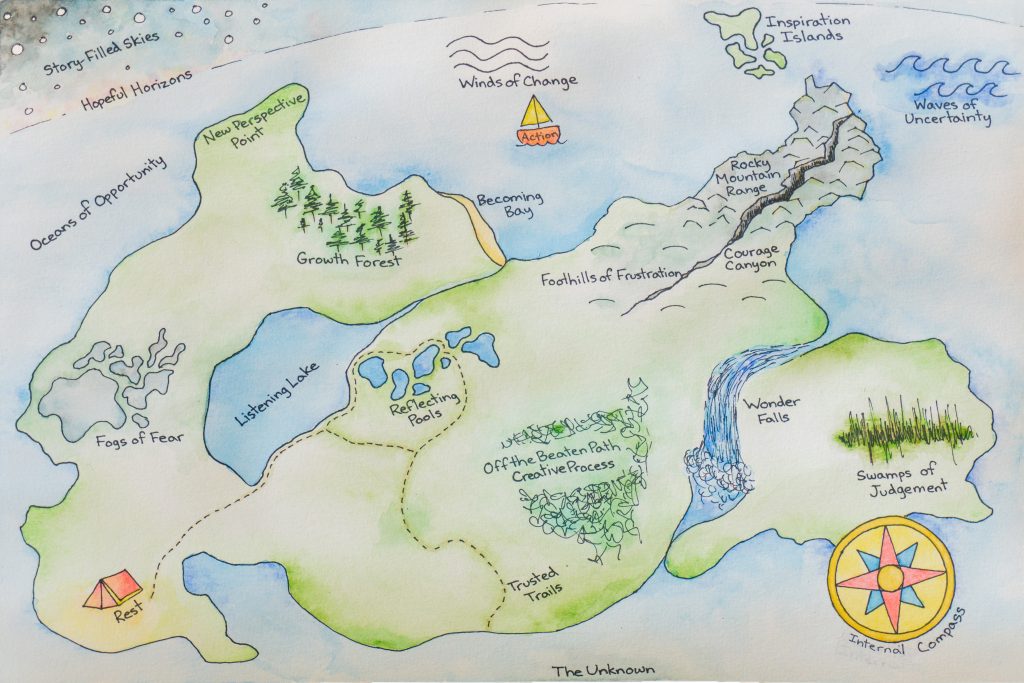|
Getting your Trinity Audio player ready...
|
Wayfinding: the ways in which we orient ourselves in a physical space and navigate from place to place. Or the process and experience of locating, following or discovering a route through and to a given space.
When we find ourselves in a new place, feeling lost (or actually lost), we look for signs, landmarks and other resources to help us find our way. Wayfinding is a part of everyday life that helps you know where to go when finding your way. This navigation method, architectural term and discipline of design takes a cross-disciplinary approach to help people find their way, using a range of systems from visuals to the environment, texture and more.
We can also learn from and apply this wayfinding concept in career conversations. There is much to learn as we find our way through the world. Today, I’d like to invite you to pause and learn from wayfinding designers. I have found it interesting to explore and learn from the key concepts of wayfinding design, connecting some of these ideas to how we work with clients and navigate liminal space, each in our own way.
Create an Identity at each location, distinct from all others

Spaces that share common design elements (like matching door colours) make each area distinct and help people know when they’re in the right place or if they have strayed from their intended destination.
Understanding and clarifying the main topic your conversation needs to focus on at the beginning of a coaching session helps keep the conversation on track. It also makes it easy to notice when the conversation drifts off course or the main theme changes. Holding a close-up view of the conversation simultaneously with a more meta-perspective can help you pick up cues and develop a deeper understanding of the overall experience as you walk with your client. Understanding not just what you’re going to be focusing on but also developing a clear understanding of how you will work together is an important consideration.
Putting it into action: Invite your client to reflect on how they like to learn or a time in life they’ve felt supported (perhaps by a mentor, coach, teacher, etc.). Identifying patterns and ways of learning can help you clarify how you will work together. Discovering what makes your client unique helps you both understand how you can best work together, as well as the ways you might get back on track should you veer too far off course.
Use Landmarks to provide orientation cues

Marking meaningful locations provides reference points that help maintain a mental map and sense of direction. For instance, when we consider a city, we use landmarks (e.g. bodies of water, distinct buildings, etc.) as recognizable points of reference to remember the city’s uniqueness or explain the place more clearly.
When working with clients and groups, using anchoring elements to reflect and organize thoughts can be immensely valuable. This allows clients to recall the conversation and revisit insights they might have gained. Working with clients to identify key insights and landmarks in your conversations can create more memorable experiences and ways for them to orient themselves to these conversations as they move forward.
Putting it into action: Using creative strategies to identify or gain new insights is invaluable. Try using physical movement, metaphors, tactile objects or even a change of environment to help clients move from just talking to exploring their experiences and learning about themselves. Consider how you might make small changes to work with your clients in memorable ways.
Create well-structured paths

Having structure when moving from one space to another can help ease navigation through clear communication and strategically designed signage and pathways. Creating clear boundaries can help travellers reach their destination faster without getting lost.
In a coaching conversation, structure can take on different forms. This may be introducing an exercise or line of questioning to help your client find clarity. The structure of a coaching conversation helps both coach and client find their way to a meaningful ending. Without structure, we could easily wander around in circles with a client without getting anywhere. With some structures in place, a direction can be identified and a course set. It is important to note, however, that the structure needs to be held lightly – allowing space for adaptation or finding a new destination.
“Creating clear boundaries can help travellers reach their destination faster without getting lost.”
Putting it into action: Rather than thinking of structure as something you need step-by-step instructions for, finding exercises or lines of questioning that balance structure and adaptability is important. Understand the intention behind the exercises or lines of questioning you like to use. How you phrase the questions or prompts, and even the materials you use, can change without losing their integrity or what you’re hoping to explore.
Use survey views (a vista or a map)
Stepping back or seeking a broader vantage point helps gain a sense of place and identify the best plan of action to get where you need to go.
It is easy to begin moving toward a destination without pausing to understand the space you are navigating. Taking a broader perspective of a coaching conversation provides both the coach and client with a moment to reflect on emerging themes and to recognize a range of perspectives or vantage points. The path to the end goal may not be clear, but as you find your way to a new vantage point, new routes around barriers may appear, and opportunities for creativity may emerge, revealing a new way forward.

Putting it into action: Using strategies such as mapping can help clients consider a range of perspectives and support them to develop a plan of action while also considering various perspectives. Consider using different types of maps to explore different perspectives, such as a transit map, a trail map or even a metaphor map.
It is important to note the purpose of design when it comes to developing wayfinding systems. Intentionally creative wayfinding can inspire new ways of thinking and approaching spaces with a greater purpose. Reflecting on the coaching conversation, it is helpful to maintain an awareness of the purpose and intention behind our work, allowing space for inspiration and creativity in service to the clients we support.
In this article, a connection has been made to individual coaching conversations specifically. The soon-to-launch virtual workbook, Career Wayfinder; Discovering Your Career through Delightfully Practical Projects, is a guide that provides creative activities and landmarks to help people find their way.
Hopefully, you will be able to find your own way to apply these concepts in the career conversations you’re having. Enjoy the ride, and please connect if you would like to share the journey.





